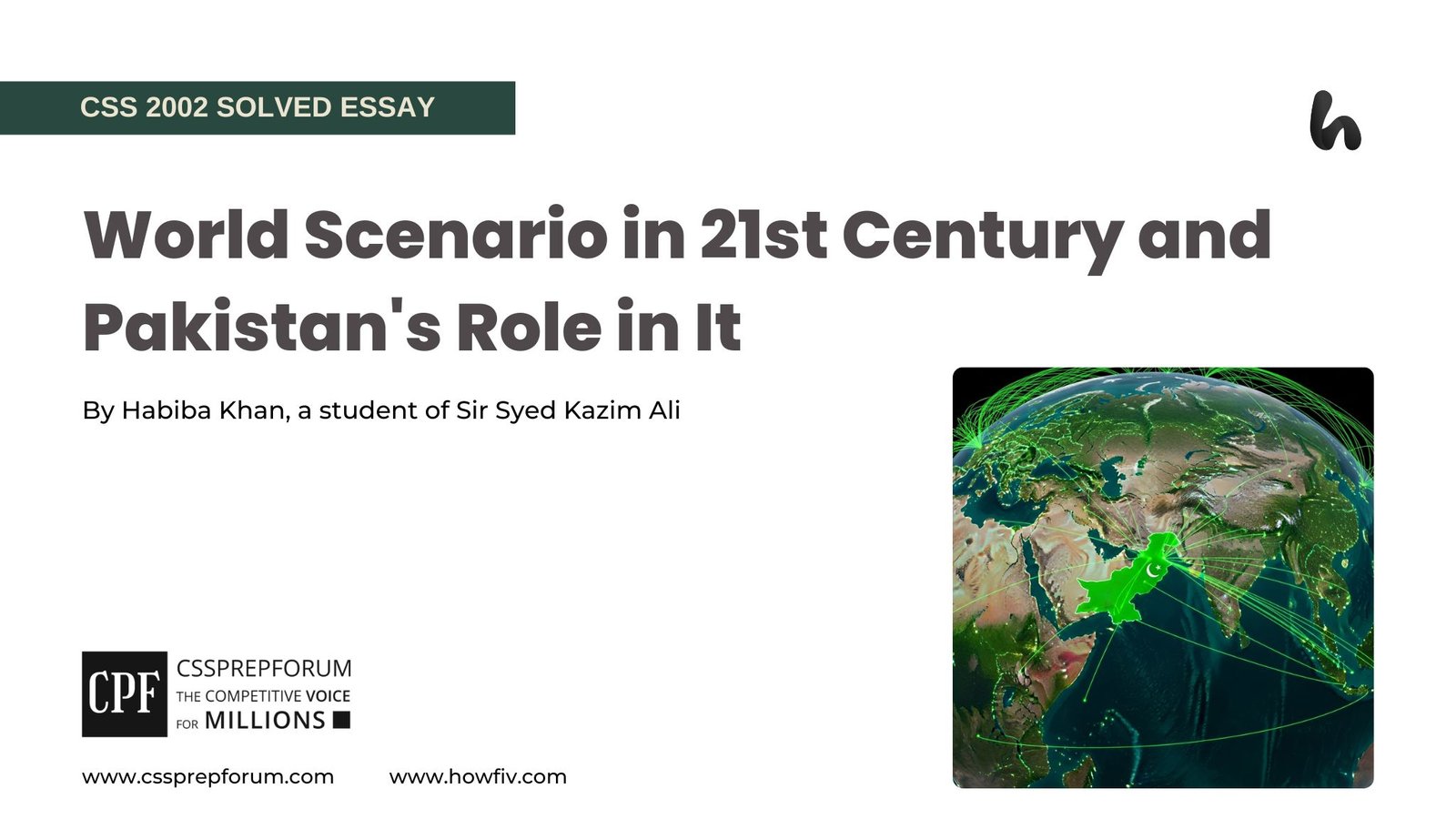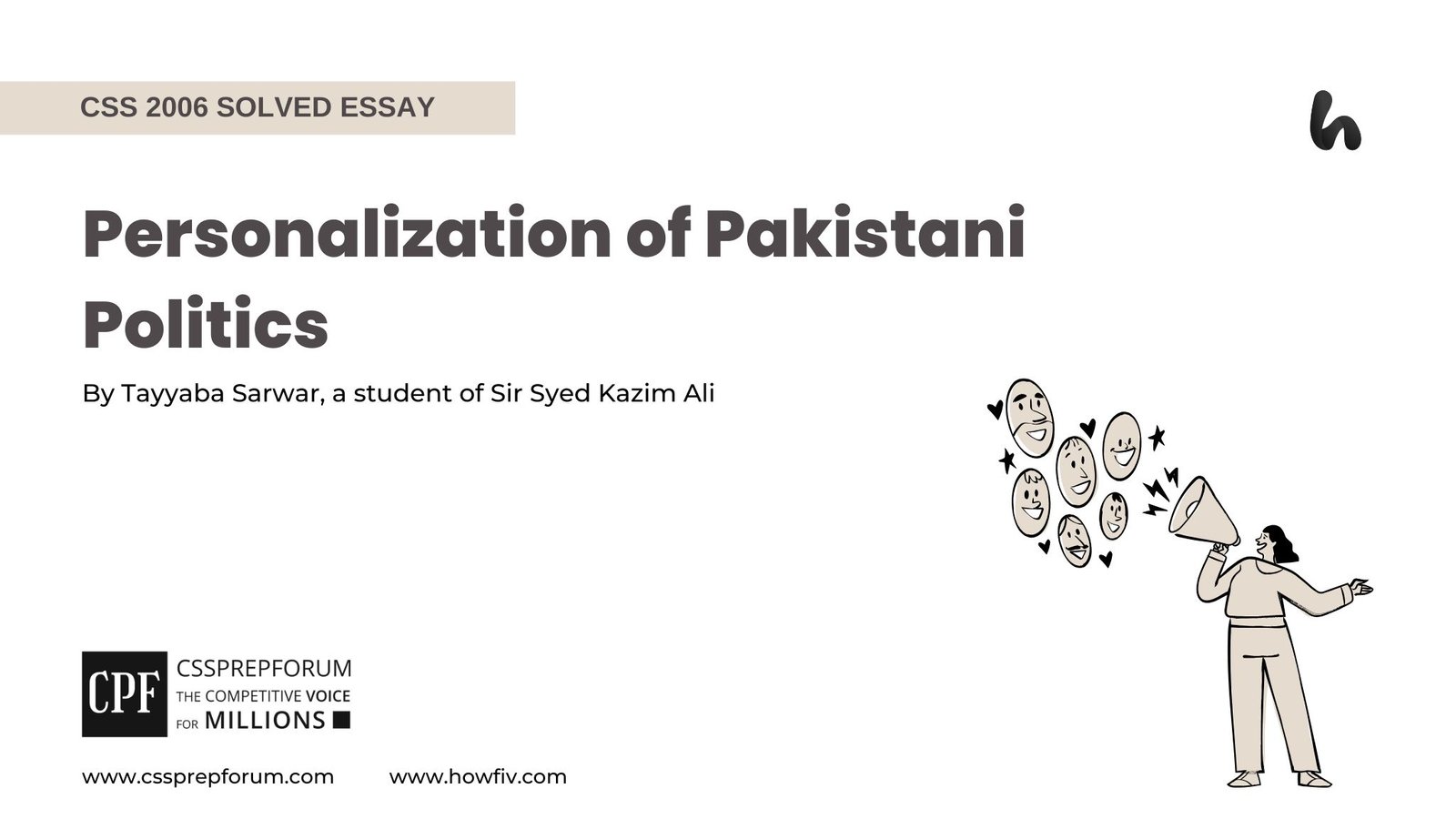CSS 2011 Solved Current Affairs Past Paper | Mechanism to Handle Pakistan’s Economy
The following question of CSS Current Affairs 2011 is solved by Sir Ammar Hashmi, the best Current Affairs Coach, on the guided pattern of Sir Syed Kazim Ali, which he taught to his students, scoring the highest marks in compulsory subjects for years. This solved past paper question is uploaded to help aspirants understand how to crack a topic or question, write relevantly, what coherence is, and how to include and connect ideas, opinions, and suggestions to score the maximum.

Question breakdown
The question inquires about how Pakistan can reduce its foreign debt and what mechanisms can be employed in the economy to address external challenges, including trade balance and financial stability.
Outline
1-Introduction
2-A bird’s eye view of the foreign debt of Pakistan
3-How can Pakistan reduce its burden of foreign debt?
- ✓Debt Restructuring and Maturity Extension
- ✓Privatization of debt-producing state-owned enterprises (SOEs)
- ✓Boosting value-added exports and import substitution
- ✓Introducing unpopular fiscal discipline and revenue mobilization through critical tax reforms
4-Mechanisms in Pakistan’s economy to handle the external perspective
- ✓Attracting Foreign direct investment (FDI) and channelling remittances
- ✓Diversification of Trade Partnerships
- ✓Digital Transformation and Innovation
- ✓Energy and Infrastructure Development
4-Conclusion

Answer to the Question
Introduction
Pakistan’s economy is experiencing a rough patch, primarily due to its recurring boom-and-bust cycles. However, a significant factor contributing to this vicious cycle is Pakistan’s dependence on foreign debt, which has been accumulating for decades and has now reached an unsustainable level. Therefore, Pakistan needs to prioritize reducing its reliance on foreign debt. To achieve this, the government must take several critical steps, including seeking debt restructuring and maturity extension, privatizing debt-producing state-owned enterprises (SOEs), and implementing unpopular fiscal discipline and revenue mobilization through targeted tax reforms. Moreover, alongside debt reduction, the government should devise mechanisms to handle the external aspects of Pakistan’s economy. These include attracting foreign direct investment (FDI), channelling remittances, diversifying trade partnerships, and boosting innovation in the country. Without these measures, it will become increasingly complex, day by day, to improve Pakistan’s economic situation. Thus, the time to act is now, before it’s too late.
A bird’s eye view of the foreign debt of Pakistan
Pakistan’s foreign debt situation is complex, with a total external debt of approximately $131.1 billion as of December 2024. The country faces significant debt servicing obligations, with approximately $30.35 billion due in FY25. Despite a slight improvement in the debt-to-GDP ratio to 20.2%, the overall external debt remains substantial, at approximately 35.1% of the GDP. Factors contributing to this include fresh loans and ongoing economic recovery efforts. Challenges persist, including rising debt servicing costs and a substantial current account deficit, which necessitate strategic reforms to boost exports and attract foreign investment, ensuring long-term financial stability.
How can Pakistan reduce its foreign debt burden?
There are various ways in which Pakistan can reduce the burden of its foreign debt. Some of the most significant ones are as follows.
- Debt Restructuring and Maturity Extension
The first and foremost step that Pakistan should take is to pursue its debt restructuring and maturity extension. Doing so will help Pakistan safeguard a breathing space for its economy. According to the IMF, Pakistan has successfully increased the average maturity of its debt from 2 years and 8 months to 3 years and 3 months by December 2024, thereby reducing refinancing risks. However, the government should continue to extend debt maturities to mitigate short-term rollover risks and negotiate better terms with creditors. In this way, Pakistan can reduce the burden of its foreign debt.
- Privatization of debt-producing state-owned enterprises (SOEs)
Second, the state of Pakistan should seriously consider privatizing its debt-generating state-owned enterprises (SOEs) to reduce the burden of foreign debt. According to the World Bank, Pakistan’s state-owned enterprises (SOEs) are among the worst-performing globally and have accumulated losses of nearly Rs. 6 trillion over the last decade. This shows the precarious situation of Pakistan’s state-owned enterprises. Thus, by doing so, the state can reduce the burden of foreign debt.
- Boosting value-added exports and import substitution
Third, the Pakistan government should focus on boosting the value-added exports and import substitution to reduce the burden of foreign debt. As of now, Pakistan’s exports have remained stagnant, with little to no increase over the past few years. On the other hand, the country’s imports have skyrocketed multiple times in the past few years, with a peak in FY21, when imports reached a staggering $ 80 billion. Thus, it is the need of the hour for Pakistan to focus on high-demand exports, such as the IT sector, while also adding value to its contemporary exports. Additionally, the state should facilitate import substitution industries by providing various benefits, such as tax holidays. By holistically following all these aspects, the state can overcome the menace of foreign debt.
- Introducing unpopular fiscal discipline and revenue mobilization through critical tax reforms
Last, the state should introduce unpopular fiscal discipline and revenue mobilization through critical tax reforms. Through fiscal discipline, the government should eliminate all unnecessary expenses, including extravagant subsidies and perks for government servants in various departments. Additionally, the state should enhance its revenue collection by implementing critical tax reforms, and those outside the tax net should be considered tax evaders, not criminals. Currently, Pakistan’s tax-to-GDP ratio is abysmally low, at nearly 10%. To improve the revenue situation, this needs to be brought to at least 14%. In this way, the state can reduce the burden of foreign debt.
Mechanism in Pakistan’s economy to handle the external perspective
Evaluating Pakistan’s economy from an external perspective requires addressing broader challenges beyond just debt reduction. The following are some of the significant mechanisms in this regard.
- Attracting Foreign direct investment (FDI) and channelling remittances
First, to address the external perspective of Pakistan’s economy, the government should attract Foreign Direct Investment (FDI) and channel remittances, as these are the most pervasive challenges facing Pakistan’s economy. Pakistan has seen a sharp decline in its FDI figures since the post-9/11 scenario and is now hovering under $ 1 billion. This can be done by creating a business-friendly environment in the country. Additionally, due to the poor management of exchange rates and inadequate checks and balances, overseas Pakistanis have resorted to using grey channels to obtain better exchange rates. Now, the state should work on both these aspects to handle the external perspective of Pakistan’s economy.
- Diversification of Trade Partnerships
Second, the state should diversify its trade partnerships beyond the contemporary few trading partners. Currently, Pakistan is primarily aligned with China, the United States, the Gulf Cooperation Council (GCC), and a few European Union members, and this alignment is achieved mainly through GSP+ or Most-Favoured-Nation (MFN) status in most cases. The Pakistan government should urgently take this matter to broaden its trade partnerships. It should also reach out to its neighbours, as well as various other underdeveloped and developing countries, such as African countries. Also, the state should facilitate participation in global as well as regional expos to boost its presence as an exporter. By doing so, the state can handle the external perspective of Pakistan’s economy.
- Digital Transformation and Innovation
Third, the incumbent government should focus on digital transformation and promoting innovation nationwide without any discrimination. This can be done by following programs like URAAN from their core. Additionally, the state should support entrepreneurial programs and innovations to boost the local industry and reduce imports. The state can implement an import emergency to reduce imports and promote local produce and innovation. Just as in the case of COVID-19, when students from Pakistan’s top engineering universities made a breakthrough by developing ventilators tailored to local needs. The exact path should be followed in the IT sector’s promotion and other sectors to handle the external perspective of Pakistan’s economy.
- Energy and Infrastructure Development
Last but one of the most critical aspects of Pakistan’s economy is its dependence on imported energy sources due to inadequate energy infrastructure development. Due to this, energy products account for a significant portion of Pakistan’s import bill. Additionally, due to Pakistan’s import dependence, local consumers are often uncertain about energy tariffs, and any global shock creates a ripple effect in the country’s energy sector. All of this can be averted by promoting greener and more sustainable energy production methods in Pakistan, such as solar and wind energy. Solar power alone has the potential to generate 50 GW of energy in Pakistan. Thus, the state should focus on developing Pakistan’s energy infrastructure to address the external perspective of the country’s economy.
Conclusion
Conclusively, Pakistan’s rising foreign debt and external economic vulnerabilities require urgent, multi-faceted reforms. The government must focus on restructuring debt, privatizing inefficient state-owned enterprises, and enforcing fiscal discipline to reduce reliance on borrowing. Simultaneously, addressing external challenges through export diversification, attracting FDI, formalizing remittances, and expanding trade partnerships are crucial. Investments in digital transformation, energy infrastructure, and industrial innovation can enhance economic resilience and reduce dependence on imports. By implementing these strategic measures, Pakistan can achieve long-term financial stability, strengthen its external economic position, and break free from the recurring cycle of economic distress. The time to act is now.

CSS Solved Past Papers’ Essays
Looking for the last ten years of CSS and PMS Solved Essays and want to know how Sir Kazim’s students write and score the highest marks in the essays’ papers? Then, click on the CSS Solved Essays to start reading them.
CSS Solved Essays
CSS Solved Current Affairs Past Papers
Looking for the last fifteen years of CSS Solved Current Affairs to learn how to attempt them and to score high? Let’s click on the link below to read them all freely. All past papers have been solved by Pakistan’s top CSS Current Affairs coach having the highest score of their students.
CSS Solved Current Affairs
CSS Solved General Science & Ability Past Papers
Want to read the last ten years’ General Science & Ability Solved Past Papers to learn how to attempt them and to score high? Let’s click on the link below to read them all freely. All past papers have been solved by Pakistan’s top CSS GSA coach having the highest score of their students.
General Science & Ability Solved Past Papers












